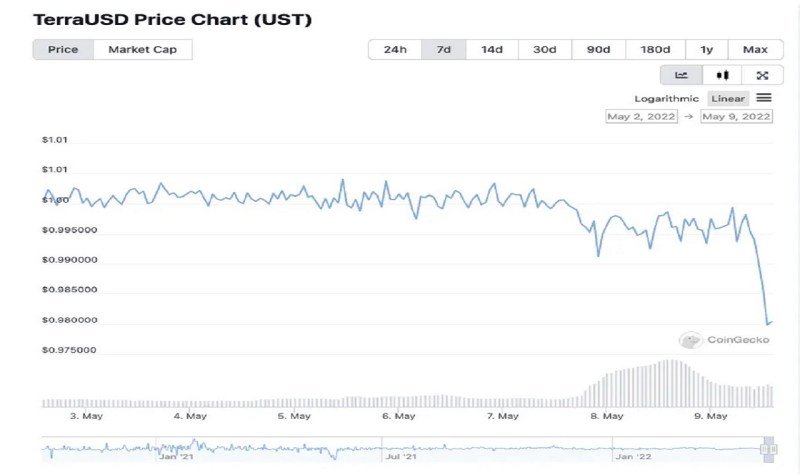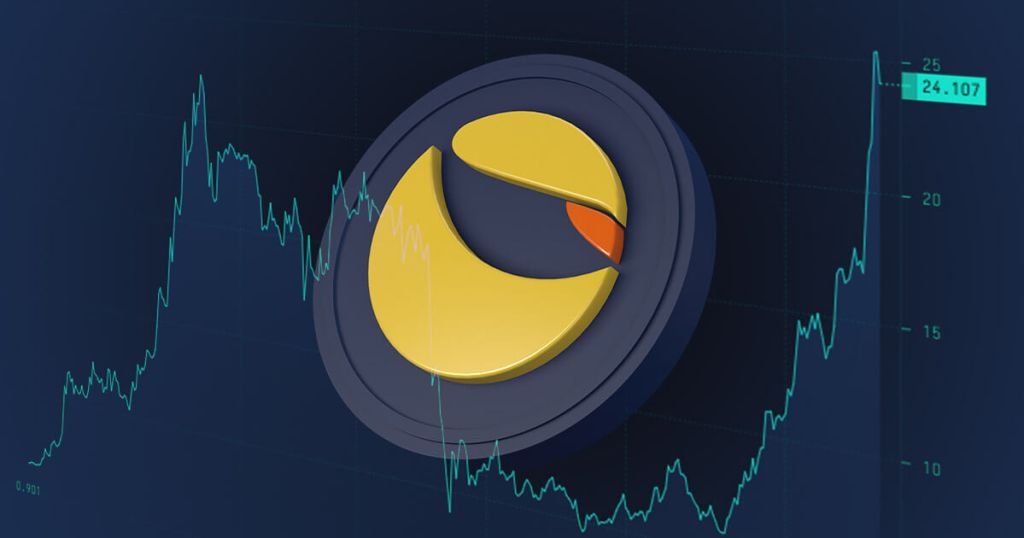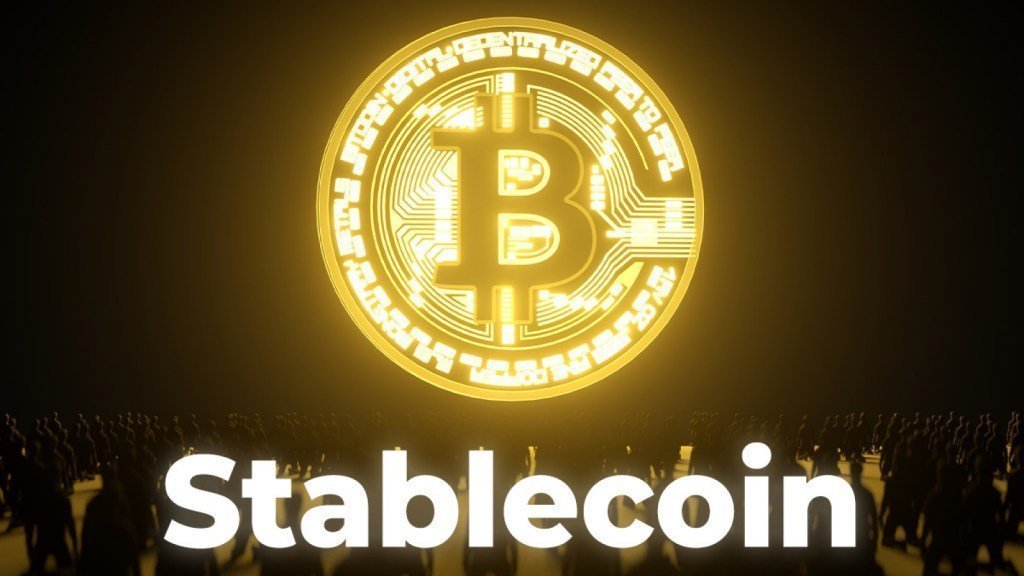Algorithmic stablecoin Terra USD (UST) struggled to maintain its stable value during the Bitcoin (BTC)-led crypto crash. The Terra ecosystem and UST are now among the most controversial topics in crypto. Experts interpret Terra and BTC collapse.
UST, the algorithmic stablecoin of the Terra ecosystem crashed
A stablecoin is a cryptocurrency pegged to a reserve asset such as a fiat currency or gold. The stability and reliability of stablecoins means they offer an accessible way to enter and exit the crypto market. But over the weekend, the algorithmic stablecoin UST, which is linked to the Terra ecosystem, diverged from the dollar amid crypto market volatility.
The dips continued into the weekend for the always-on crypto market. As of Friday, Bitcoin (BTC) has dropped 6% to around $30,700 as of 14:58, according to data from CoinGecko. As you can follow from Cryptokoin.com news, on Saturday, Terra’s UST started to lose its peg against the dollar and the ecosystem’s governance token LUNA, which plays a role in maintaining the stability of the UST, fell by 15% in 24 hours.

Some believe the loss in peg was dropped by a crypto whale on a key UST to Tether (USDT) exchange that took place on Curve Protocol. Fans of the Terra ecosystem known as ‘LUNAtics’ questioned whether this was a coordinated attack by a rival. The fixation began to improve when Terraform Labs CEO and co-founder Do Kwon took up the issue on Twitter.
I’m up – amusing morning
Anon, you could listen to CT influensooors about UST depegging for the 69th time
Or you could remember they’re all now poor, and go for a run instead
Wyd
— Do Kwon 🌕 (@stablekwon) May 7, 2022
The collapse caused intense discussion
The Terra ecosystem is being watched closely as both the governance token LUNA and stablecoin UST have quickly climbed the ranks of cryptocurrencies by market cap. A burn mechanism using the LUNA token and a reserve of digital assets such as Bitcoin is used to keep the stablecoin pegged to the dollar. However, critics have cast doubts on the arbitrage mechanism between LUNA and UST.
In March, two pseudonymous crypto traders from Sensei Algod and GRC challenged Kwon to place a bet that the price of the LUNA token would be lower than $88 a year from now on. Kwon accepted both bets and sent a total of $11 million UST to an Ethereum wallet owned by another crypto trader known as Cobie, who served as the custodian of the funds.
To further boost the UST, Kwon has pledged to purchase $10 billion worth of Bitcoin to support the stablecoin. Some market participants questioned what would happen to Bitcoin’s price and support level if Terra stopped buying or the network suddenly suffered a loss in investor confidence.

Luna Foundation Guard, a nonprofit launched to grow the Terra ecosystem, on Monday announced $1.5 billion in capital to ‘calm down market concerns around the IHR’ and maintain stability. voted to distribute. Despite these measures, UST has diverged for the second time and LUNA has lost more than 50% in 24 hours.
1/ The LFG Council just voted to deploy 1.5B in capital (0.75B in BTC, 0.75B in UST) to allay market concerns around UST. Some more context on why and how: https://t.co/TfaAPkzgUJ
— Do Kwon 🌕 (@stablekwon) May 9, 2022
Crypto investors believe that algorithmic stablecoins should be stable and reliable assets. They also expressed concern about the complexity of their care. Others argue that stablecoins are truly decentralized, meaning they fall outside the jurisdiction of regulators and governments.
Crypto experts’ views on Terra and the stablecoin ecosystem
FTX’s head of ventures, gaming and M&A Amy Wu
Absolutely an area of great interest. Basically I think it’s pretty unstable. It’s a really interesting thought experiment, isn’t it? I actually think it’s a pretty fascinating technology. I just think it can replace the fiat currency, I think you will run into consumer protection issues due to its instability. I believe in USDC backed by real assets.

John Darsie, general manager at SALT and director of business development at SkyBridge
We think he has changed the financial system. I believe it should explore more ‘actively and aggressively’ regulating decentralized stablecoins, backed entirely by assets and managed by private companies like USDC, rather than governments and regulators focusing on creating a central bank digital currency. We think the algorithmic stablecoin market is a bit risky and dubious, but you can get a fully supported, private and transparently tracked stablecoin.
Hxro Network founder and CEO Dan Gunsberg
I think they can be useful in the right hands. In the wrong hands, they can be very problematic. After all, these kinds of things are what got us in trouble in 2008. Although on a much smaller scale, they could have the potential to be systematically disastrous.

Peter Johnson
, co-head of private investments at Brevan Howard Digital We’re big fans of what they’re doing and just adopting stablecoins in general. We are investing in the big macro changes we see coming. And one of them is the adoption of stablecoins, which will be a new way for money to move around the world.
Crypto Finance (Brokerage) AG CEO Patrick Heusser
There is always some value as they try to restart liquidity. I encountered high interest rates or other incentives offered to early users. So I tried to get in early, make some money, and then exit. One of my former bosses always used to say that “where there is a currency, there is a currency to break”,
The Anchor Protocol burns about $5 million a day in its treasury to maintain efficiency. My understanding is that they do this to accelerate liquidity and drive adoption, but at some point you have to come to an economically reasonable place. You can’t subsidize that forever.

Ming Wu
, Founder and CEO of Strips Finance, on the sustainability of Anchor Protocol’s current high double-digit percent return I am also skeptical. That’s why I believe the interest rate can settle between 4% and 10%. If the carry trade is more than 10%, then market makers will always be willing to borrow less than 10%. I think the sustainable level is between 4% and 10% depending on how much the transport expands. Moreover, you have to start asking where this yield comes from.
If I have more capital than you, I can generate higher returns and market share from your protocol for longer. But once you gain market share and kill other competitors, you run out of money and then someone else comes along. In a sense, UST could already become ‘too big to fail’ after raising collateral to support the stablecoin, including billions of Bitcoins and $100 million in AVAX. Because if the UST collapses, then that collateral needs to be sold in the market, which will kill any protocol.





